Short Horror Manga Lightning Reviews
Content warnings:
Varies; see individual series below. Some are worse/more intense than others
so be safe!
---
I like dark and unusual content, but a lot of times, it's difficult to
find things that actively interest me. I guess 'difficult' isn't
necessarily correct, but it does involve a fair amount of digging around
random rabbit holes and finding recommendations from people who already
liked the same sort of things I did. That being said, I open up my
horizons a bit wider for things that won't take me that long to read or
watch. I'll sit through a dozen or so chapters of something that might
not be exactly my cup of tea in order to parse through it and see if I
get anything out of it, and to be honest, that's what I do with a lot of
dark media - grab the stuff I think is thought-provoking or cool, file
it away for my perusal or use later, and then ditch the rest of it. I
kind of enjoy this method of consuming media, because I end up finding
some really interesting and disturbing bits and pieces throughout things
I might not have otherwise tried if they were longer, and then I
literally just forget about whatever parts didn't resonate with me.
Win-win.
I recently started making heavy use of the recommendation features on
AniList, and wow, there are a LOT of things on there that catch
my attention at first glance. How many of them are good or worth
reading? That remains to be seen. What I will say, though, is that
anything that catches my eye and clocks in at around 20 chapters or
under is fair game. I can spend an hour of my time on a manga that turns
out to be mediocre, I don't mind - maybe I'll find something really
unique buried in the middle of it! So, this page will be a list of short
(around 20 chapters or under) manga that I've read with some quick
thoughts about them. Please pay attention to content warnings, and also
do more research if necessary before you plan to read them, since I may
miss some things!
---
10/28/23

Akumu Koushounin/Nightmare Negotiator (2007) by
Takahashi
Yousuke
Chapters: 11
Content warnings: Animal and infant abuse, sexual
assault and pregnancy horror (chapter 6); suicide (chapter 7), some gore
Recommended: An interesting read - yes!
After being disappointed to find out two infamous manga I wanted to try
to review for this page were too graphic and gross for me to stomach, I
decided to go through my reading list and pull out another Takahashi
Yousuke collection. It feels like he just never misses!! I guess I just
really respond to his strange and mystical approach to horror.
The first four chapters follow the same character, a 'nightmare
negotiator' who frees people of their nightmares - for a fee, of course.
It was interesting to see a somewhat connected story here, albeit an
episodic one. Chapter 5, 'Street Stall,' had an exquisite build-up in
tension, and is a great example of a story where the ending raises more
questions than answers. Chapter 6 was gratuitious and somewhat gross,
focusing on rape and pregnancy, so if you want to skip that one it's not
a big loss. I feel like Chapter 7, 'Home Visit,' deserves a second read
through right after you've read it the first time! Chapter 10, 'Indian
Magic Trick,' has a weird sort of fetishistic vibe to it...?? But other
than that, I really like the sort of whimsical and humorous way it was
told, and there was a good wham line right in the middle of the chapter.
Chapter 11, 'Reset', feels like a pitch for the best shonen manga that
never existed. It was a great concept! I loved all of the strange ways
that the author played with time, repetition, and perception in this
collection.
---
04/26/23
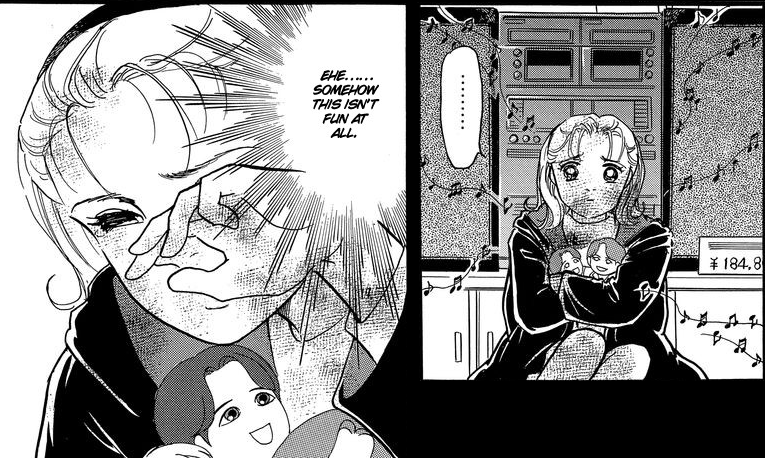
Yoshimi Seki Horror Collection: Panic! Atashi Shinu no? / Yoshimi Seki Horror Collection: Chou Ego! Atashi Saite? (2016) by
Yoshimi Seki
Chapters: 4 + 4 for a total of 8
Content warnings: Multiple attempted assaults of minors (chapter 1); self-harm, including with blades (chapter 6); emetophobia, disordered eating, body image issues, fatphobia (chapter 8)
Recommended: Yes; all of them were quite interesting. The first one in particular was extremely thought provoking.
This entry is technically for two different short story collections by Yoshimi Seki, but when I read them, they were collected together. The first collection contains four stories centered around young girls confronting their imminent death, and the second collection is more about girls facing complicated questions of ethics and morals. Both were very engaging themes for a horror collection, and I have to say I think I enjoyed every single one of them (albeit to differing degrees), which was a nice surprise. These one-shots were originally published in Horror M, and as it turns out, I think I just have a huge bias for Horror M authors, lol!
I won't talk about every single one-shot in the collection, but I will comment on some of them. 'Countdown to Despair' was genuinely fascinating from start to finish, and kind of horrific in multiple different ways as the story went on. It went from empty and slightly sad, to desperate, to strangely poignant, and ended with a kind of wham line that took the plot in a completely different direction. I was very impressed. 'Locked Door' meandered slightly too long, but the overall twist I think was worth it. 'The Red Flower of Despair' stood out to me as being a horror story with a hopeful ending; I can't remember the last time I saw a story like that. 'The Prince of Unhappiness' was quite interesting as an excercise in morals through the perspective of a very young child. I found something interesting in each one of these stories, and would like to read Yoshimi Seki's other work, though her catalog doesn't seem to be as expansive as some of the other one-shot authors I've talked about up to this point.
---
12/13/22

Bijo Amanda/Beautiful Amanda (2008) by
Rei Mikamoto
Chapters: 5.5
Content warnings: Nudity, gore, attempted sexual
assault (chapter 3)
Recommended: I say yes! I really liked it anyway, lol.
Yay, another manga for this page that I genuinely liked! I've been
reading Chimamire Sukeban Chainsaw (NSFW) by the same author and
honestly having a wildly fun time with it, more than I expected to. Rei
Mikamoto's art is super appealing to me; it's all huge eyes, long
lashes, violence that's supremely exaggerated but not realistic enough
to be off-putting (at least for me). It can also be very squishy, round
and cute, too, when he draws chibi style characters. Anyway, I think his
art is very fun, and his brand of violence is creative and fun, too. His
stuff is definitely not for everyone (read: naked women everywhere and
frequent references to assault), but I think this collection is a good,
mild introduction to what his work is like, based on what else I've
seen/read by him.
Bijo Amanda is a collection of five horror one-shots. In the first
chapter, a group of high schoolers visit an old man and his wife to
write a newspaper article about them, only to discover that his wife is
an obsessive and murderous being. In the second, a lonely boy who spends
his time drawing beautiful, imaginary women is approached by a real
girl, but his artwork gets in the way. In the third chapter, a young
girl takes a job as a maid in a house with a strict punishment system.
The fourth chapter is about two elementary school students who become
friends with Amemiya-san, a spirit who takes friendship extremely
seriously, in order to get access to her magical belongings. Finally,
the last chapter introduces Iida-san, an elementary school lunch lady.
She cares deeply for the children and wants to do everything in her
power to keep them well-fed and happy. I might be biased because I came
into this manga already enjoying his other work, but I think he's got a
lot of creative ideas and manages to keep them entertaining from start
to finish. He's probably the type of author where you will either really
vibe with his work, or check out of it pretty quickly if it's not your
thing.
---
12/02/22
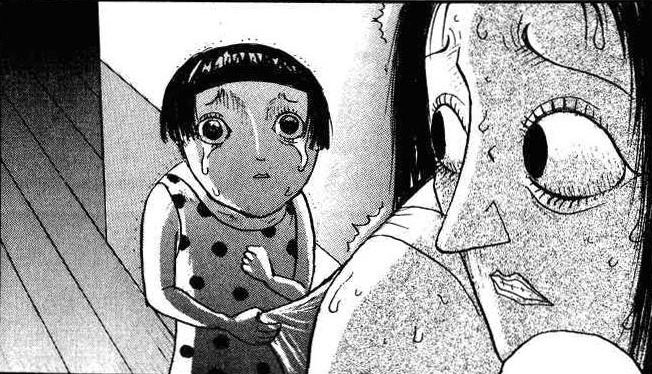
Fear Infection (2006) by Ochazuke Nori
Chapters: 9
Content warnings: Body horror, gore, child abuse,
extreme dental gore
Recommended?: Probably a pass.
None of these shorts were exactly 'excellent,' but I wasn't bored while
reading them, that's for sure. Nori's art style is sort of simplistic,
and his characters' bodies are quite disproportionate; it felt very
unique and enhanced the tone of the stories. I liked the overall look of
the collection.
A lot of the shorts had sort of underwhelming or open-ended conclusions,
or suddenly changed tone right at the end, which made them feel a little
weak to me. There were ones that I liked, though; the building tension
in the first one-shot was compelling, and "Paper God" was a fun
excercise in exaggerating and creating horror out of something
unexpected. That one reminded me of a short story by David Lubar about
maple leaves that I read as a kid (it's in one of his Weenie books, but
I don't remember which one - maybe Lawnmower Weenies?). "Rat Egg" was
kind of a sweet story in a way. "Ghost Club" had a gore scene in it that
was really not that explicit in what it showed, but it was so inventive
that it makes me cringe hardcore even thinking about it.
---
11/26/22
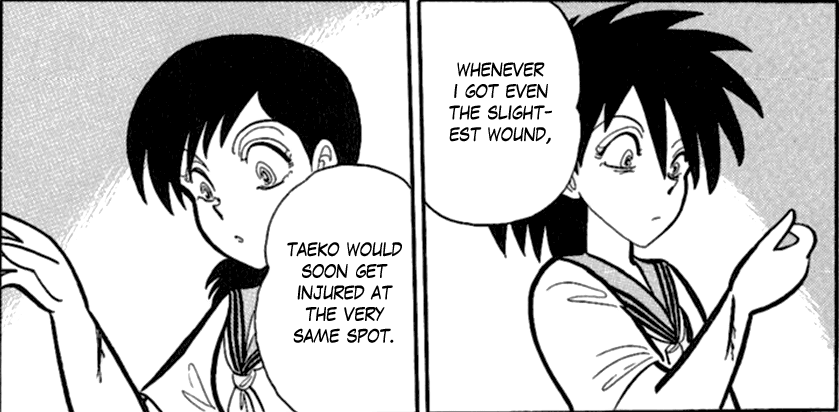
Man Eater (1997) by Takahashi Yousuke
Chapters: 11
Content warnings: Nudity, cannibalism, gore, body
horror, fatphobia, parasites, infestation, self-harm/suicide, eye and
mouth gore, pregnancy/abortion themes, infant death, one use of a
swastika in a joking manner
Recommended?: Yes!
Happy to report that I read another collection of Takahashi Yousuke's
work and he did not disappoint! These one-shots are definitely a lot
more gruesome than the ones in Tetsunagi Oni (just look at all those
content warnings, lol!) but man, they were all really enjoyable. I love
love love his artwork so much, and his sense of ironic humor is
delightfully twisted. It pushes the edge a bit, but I still find it very
charming. I love dark content that still has a mostly light or humorous
tone throughout; if you can nail that ambience, then I'm on board.
Every chapter was engaging throughout. Takahashi really has a great
sense of pacing, and his concepts are so delightfully out there. My
favorites in the collection were "Whatever You Like" and "Twin Love".
"Peas in a Pod" and "Kitsune" were also quite fun. I enjoyed how the
first and last stories bookended the collection with strangely similar
but reversed themes. Also, the last one-shot collection should take
note; THIS is how you open a collection with a baby-horror themed
chapter. The endings are both fundamentally the same in both this
collection and the last one, but this one landed.
---
11/10/22
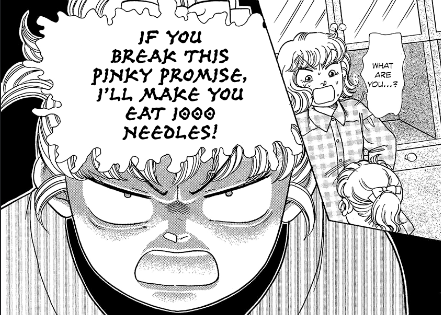
Shoujo Kaitai/Dissecting Girls (2015) by
Kaburagi Saiko
Chapters: 8
Content warnings: Incest, fetuses/abortion themes,
gore, cannibalism
Recommended?: No, not worth the time.
Man, I really wanted this to be good. Unfortunately, it wasn't. I read
it entirely because the cover (an
idol girl getting vivisected while still singing and smiling) made
it look cool and cute and interesting, but it was pretty much thoroughly
disappointing - I'm probably being harsh, but I did indeed judge this
book by its cover, and it did not give me what I wanted.
Shoujo Kaitai is a series of eight one-shots that all revolve around
girls getting torn apart in one way or another. It starts out with
probably the worst possible choice of the eight that it could have
started with, which is about a pregnant middle schooler and her
infertile aunt, who carries around a baby doll and pretends that its her
daughter. Listen, that could make for a really tense and engaging story,
but that is absolutely not what happens - it just kind of spits out some
weird anti-abortion rhetoric (??) and then uses fetuses for shock value
that doesn't land. If the collection wasn't so short I wouldn't have
bothered reading the rest of it. I just think this is the type of story
you should stick in the middle of your collection, not open it up with,
unless you can make sure it's effective. (It really was not.)
Most of the other one-shots share the same problem - they have a premise
with some potential, but they just meander too long, or they don't stick
the landing. The second chapter is the idol dissection, and I kind of
liked that one, even if it was on the nose and kind of mediocre. Chapters
three and four are about a family that has children who can consistently
regrow their flesh, and the family is addicted to eating pieces of their
body. Like, how do you mess up a premise like that?? The fifth chapter,
Wishing Doll, was alright I guess - it could have ended a lot sooner.
Chapter six could have benefitted from a more subtle touch on the gore
and I think it would have been pretty good - it's just two short
'nightmares' that a kid has. The seventh one was a little cheesy,
nothing to write about. The last story honestly could have been really
cool, and I didn't entirely hate it, it just got muddled along the way -
a girl wishes for things, and they're manifested from inside her body.
The very last page is honestly pretty spooky the more I think about it.
Anyway, this one is a big 'skip' in my opinion.
---
10/31/22

Fetish (2004) by Fujiwara Kaoru
Chapters: 5
Content warnings: Nudity, rape, parental incest,
genital torture, abortion/child abandonment (?)
Recommended?: No.
Last time, I picked up a manga just based on the artstyle; this time, I
picked one up just based on the name. I'm not really sure what I
expected from it, and I didn't do any research beforehand because it was
so short, so I just blazed through it in about 15 minutes. Fetish is a
series of one-shots that are, for the most part, centered around
relationships that lean towards the obsessive. They're not 'horror', but
the dark content makes it pretty jarring and uncomfortable to read.
Fujiwara Kaoru's art is pretty gorgeous, but the stories themselves
either lean just slightly too ephemeral (Our Vast Loneliness, Fetish) or
too shocking without real content (All of Sully/Lily, Airport) to really
be successful. The one chapter I did enjoy was Love Letter, which
wouldn't have felt out of place as a Junji Ito one-shot if it was just
slightly shorter.
Our Vast Loneliness is honestly quite interesting, but it seems like the
type of story that would benefit from a re-read, so I might end up doing
that. The storytelling in that chapter is choppy and a little hard to
follow on purpose. Love Letter was simple but effective, telling the
story of a woman who recently had surgery to restore her eyesight, but
sees a 'ghost' of herself wherever she goes. All of Sully/Lily, the
third one-shot, is just gross and creepy for unenjoyable reasons - it's
about a scientist who has a torturous, incestous relationship with a
clone of his daughter. Something like that could have been interesting
if approached the right way, but it was just too gratuitous and I didn't
feel any sense of depth to it.
Airport, the fourth chapter, is very short and abrupt - a taxi driver
drops off a pregnant woman at an airport. The final chapter, Fetish,
deals with a man who has a fetish for injured woman. It's an interesting
subject matter and was honestly an alright one-shot, but seemed a little
unsure of itself, like it was too afraid to really 'go for' the
opportunities a theme like that could bring. I could be being too hard
on the manga, honestly, since it's more psychological than full-on
horror, but still.
---
10/20/22
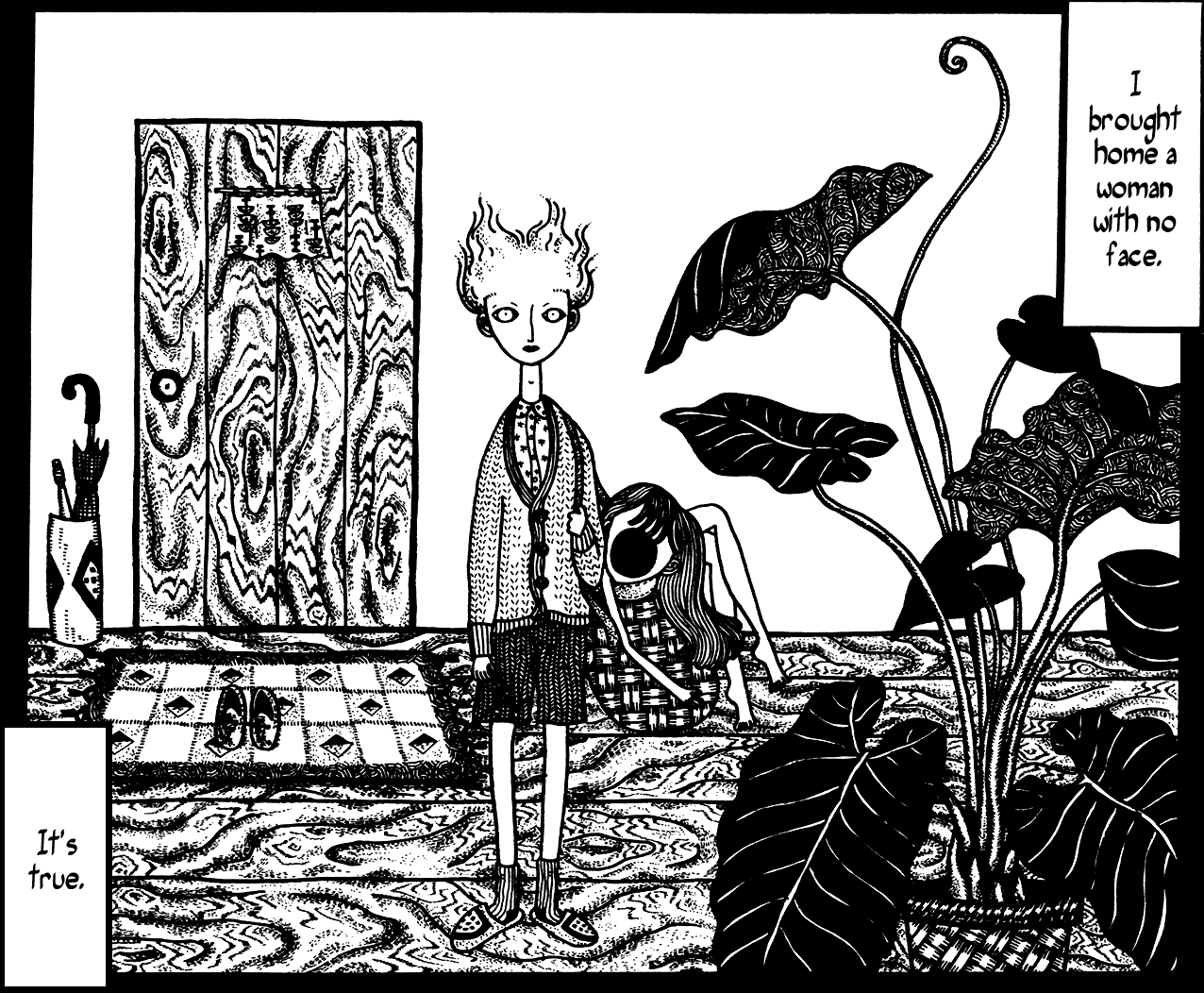
Jigoku (2000) by Nishioka Kyoudai
Chapters: 12
Content warnings: Nudity, sexual content, stylized violence, domestic abuse
Recommended?: If you like art-for-the-sake-of-art/"fake deep" media, or looking at cool pictures, then yes; otherwise, no.
I will be completely honest, I picked this manga up entirely based on
visuals. I had stumbled upon another manga by the same pair (a brother
and sister team) that looked gorgeous, but after reading a summary I
decided it pushed things too far for me and I would rather leave it
unread. Instead I picked out one or two of their other works to toss
onto my reading list.
Like the last entry, Jigoku is a collection of twelve unrelated
one-shots. However, instead of being fully fledged short stories,
they're more like eerie glimpses into an uncomfortable dream world. It
never gets 'scary', but it's definitely a little dark. Since the story
telling is so fluid and dreamlike, I never really got a solid foothold
into the manga, and honestly read it so fast that it was more like I
skimmed it. The Nishioka siblings' artwork is fascinating, so if unique
art styles are your thing, it might be worth a cursory glance just for
that. If you need a good plot to be interested in a story, though,
definitely pick another manga. If I had to pick a favorite/standout
chapter, it would be "The Woman With No Face". I do plan on reading some
of their other works eventually to get a better grasp on what they're
like as creators, because they definitely have a really interesting
artistic vision.
___
10/19/22
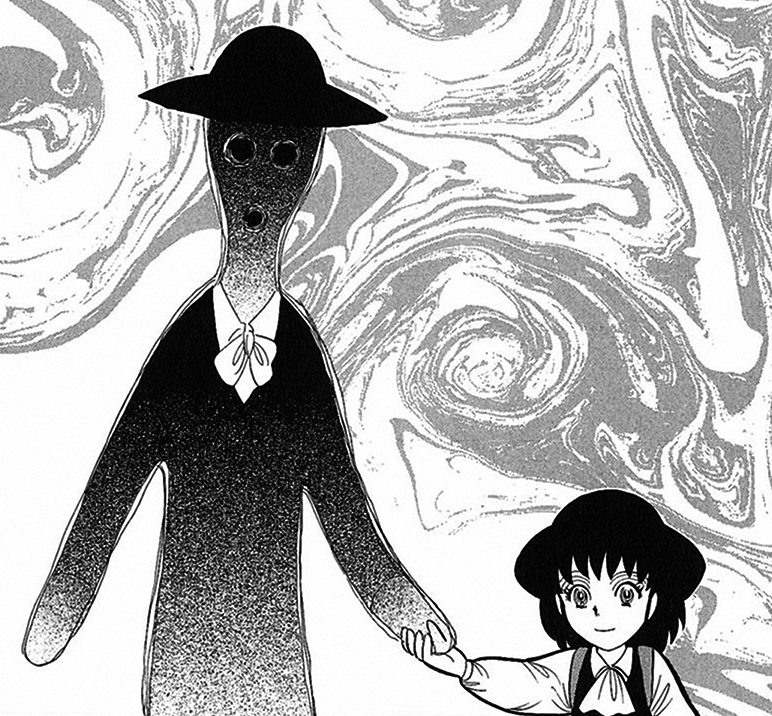
Tetsunagi Oni (1999) by Takahashi Yousuke
Chapters: 12
Content warnings: Some gore, nudity, and slight body horror (just in case)
Recommended?: Yes! 10/10 tbh.
I really, really loved this! Tetsunagi Oni is a collection of twelve different one-shots, and every single one was unique and engaging. A lot of them have a very urban legend/folktale vibe to them, which was super refreshing and enjoyable. There's also a surprising amount of humor splashed in, keeping the atmosphere very light throughout the work and making sure that the spooky parts don't go too far.
I absolutely adore the art style throughout. It's so satisfying. Some of the chapters call to mind 60's-70's manga where the side characters and monsters often have extremely exaggerated facial features, while the main characters are very soft and rounded, but the thing that really caught my attention is how pronounced the eyelashes are. I'm a sucker for any artstyle with that trait!
It's a very quick read and I definitely recommend it! Twelve short stories with interesting themes, some humorous plot twists, and a very lovely art style that prevents anything from getting too dark. I definitely want to check out his other works, too!
---
10/07/22
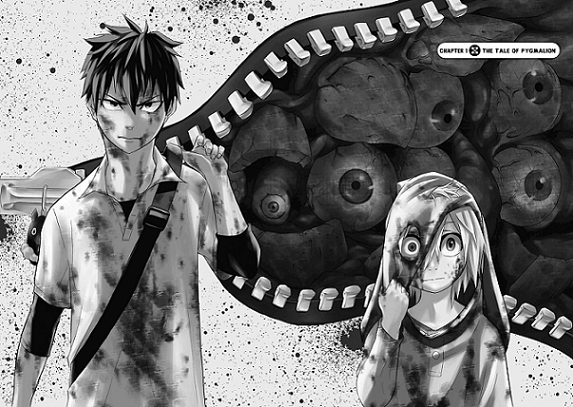
Pygmalion (2015) by Chihiro Watanabe
Chapters: 19
Content warnings: Gore, slight body horror, violent
sexual assault (chapters 8-10), gore/violence/torture happening to a
child
Recommended?: Not particularly, though it had some
interesting ideas in it towards the second half.
Pygmalion is a pretty short and speedy read, very well condensed and
self-contained. During a large mascot festival, the costumes suddenly
come to life and begin gruesomely killing and eating everyone in the
crowd. The protagonist, Keigo, is separated from his little brother
Makoto during the chaos. He eventually finds him torn to pieces,
seemingly dead - but Makoto gets back up, with half of his face merged
with that of a plush mascot. Keigo, Makoto, their friend Ako, and a
group of other characters try to survive the onslaught while getting to
the bottom of the mascots' origins.
The 'killer toy/mascot' trope is so overdone by now that Pygmalion, from
the onset, kind of suffers from that being its premise. Like, oh no, we
get it, cute happy thing kills people!! Keeping it short was a good
call, since I think it would get repetitive and boring if it went on for
too long. The first few chapters feel a little stiff because the concept
has been done to death, but there are a few gory moments that are
charming and unique in their grotesqueness and give the mascots their
own personalities - like a doll-type character wearing a 'dress' made of
torn-up women. By the second half, I was interested enough that I would
have liked to see the lore/explanations extended a bit further, but what
we get is satisfactory and serves its purpose to finish up the story
with a nice little bow. The story was just long enough for there to be
callbacks/bookends that were thematically effective.
Keigo and Makoto's relationship gets just enough development for the
reader to care about them as siblings, and feel for them. Honestly, the
other characters all felt pretty fleshed out, too, for how little time
the manga actually has, but the stand out character is the 'antagonist'
who seems to have a hand in the mascots' actions. Once that character is
properly introduced, the rest of the manga goes down smoothly, and there
are even a few plot developments that were both interesting and made
sense, a hard combination to achieve sometimes.
I honestly really liked the art in this! There are some really great
panels where the author can showcase the depth of emotion he can show on
a character's face. There were some expressions that honestly felt very
real, and made me slow down a little bit, letting me get a bit more
invested in the story and the characters' experiences. The only part I
didn't like was one particular mascot introduced in chapter 8, which
assaults its victims before killing them. It's used to show that each
mascot has its own idea of fun/what it wants to do to people, but it was
pretty gratuitious and didn't seem to fit the tone of the rest of the
manga.
---
10/05/22
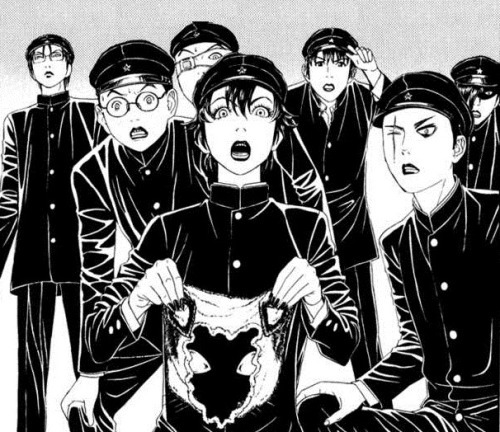
Litchi ☆ Hikari Club (2005) and Bokura no ☆ Hikari Club
(2011) by Usamaru Furuya
Chapters: 9 (Litchi) + 12 (Bokura) for a total of 21
Content warnings (oof):
Sexual violence (including towards a child), misogyny, extreme gore
(especially near the end), Nazi imagery and themes (more explicit in
Bokura), cult themes, explicit sexual acts between underage characters,
prolonged eye gore in Bokura, homophobia (?)
Recommended?: I could not in good conscience recommend
this to anybody, research and decide for yourself if you want to read
it.
Another example of my 'I heard about this, read the whole thing, and
then wrote a review of it in the span of 12 hours' trend that I seem to
be repeating on the dark side of this website. There are just some
pieces of media that are so unique/dark/wild/etc. that I need to talk
about them pretty much as soon as I've finished them.
Litchi Hikari Club, or Lychee Light Club, is about a cult of middle
school boys who worship their leader, Zera, and follow his every
command. Zera is disgusted by adults, and vows that the Litchi Hikari
Club will never follow in their footsteps, instead focusing all of their
energy on preserving the beauty of youth. The Hikari Club's main focus
is to build a robot named Lychee, who will carry out their orders - the
first of which is to kidnap a girl to serve as the club's Queen.
That's the plot on paper, but it almost immediately devolves into the
web of interconnected jealousy, violence, and confused feelings that the
members of the Hikari Club hold for each other. The Club cannot
withstand this infighting, and begins to break down, taking the members
down along with the organization itself. It's quite an... interesting
read, if you can get past the content? I will say that much. I didn't
really enjoy reading it, but it made me go, "Hm," a few times. It feels
a little bit like just checking off a bucket list piece of media or a
shock site, like, "now I can say that I've done that." I'm also going to
do what's called a 'pro gamer move' and compare it to two other things
that I've never actually read, namely Lord of the Flies and A Clockwork
Orange. Also, the overall tone kind of seemed like what would happen if
the characters in Pretty Boy Detective Club were barely containing
years' worth of pent-up violent ideation.
Litchi Hikari Club kind of just throws things at you too fast for you to
really get invested, and treats you more like an unfortunate bystander,
just watching as things happen and reacting to them. Bokura no Hikari
Club, however, is a prequel, and further details the relationships of
the boys starting from the very beginning of the Hikari Club. Bokura is
paced much better, and because of that, I was able to get invested in
the tragedy that the original kind of zoomed past. Bokura also shows
more of the thought process behind the cult's beliefs and the
uncomfortable way that Zera gets his grip on the other boys over time.
For anybody who does get all the way through Litchi Hikari Club and
isn't immediately 100% disturbed, I think the prequel is required
reading - in fact, I kind of feel like 'Litchi' is more of a preface you
just kind of sit through in order to enjoy (? not the right word) the
deeper look into the story that 'Bokura' offers. Litchi by itself might
not be worth reading for much more than some (honestly pretty shocking)
gore, but as a pair, it's much more valuable as a piece of media.
---
10/02/22
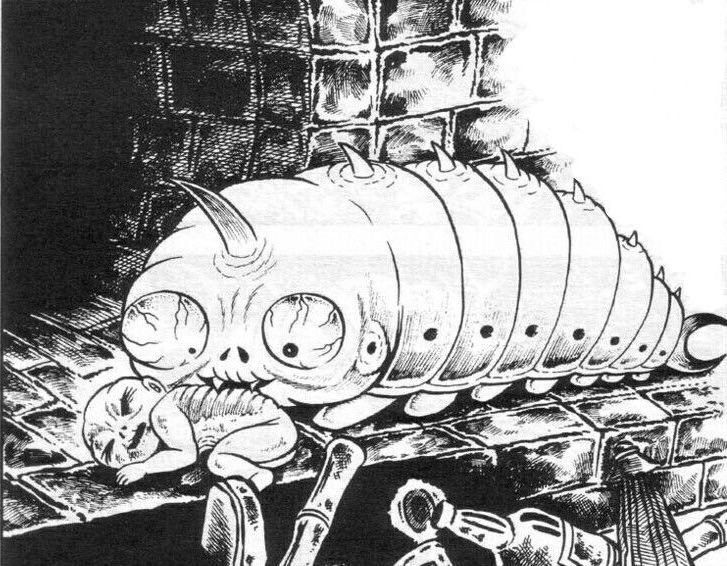
The Bug Boy (1975) by Hideshi Hino
Chapters: 12
Content warnings: Body horror, bad things happening to
a child
Recommended?: If you like vintage horror manga, yes.
Oddly enough, I've known about this manga since I was 9 or 10, because
it was mentioned in a manga guidebook my mom got for me. This
particular image was the one they used to preview it. It always kind of
freaked me out, but I didn't think about it much more than that until I
stumbled upon it in AniList and vaguely recalled hearing about it.
The Bug Boy is about a young boy named Sanpei, who is bullied in school
for his unusual interests and appearance, and beaten at home for his
failure to perform academically. Sanpei would much rather spend time
playing with bugs, rats, and snakes than be around other human beings.
One day, he gets stung by a strange caterpillar, and undergoes a painful
and horrifying transformation, ultimately becoming a mirror of the
strange caterpillar himself. At first, Sanpei is thrilled with his new
body and his new life, but things don't stay happy for long.
At risk of making the one obvious comparison that everyone will make,
this manga reminded me a lot of Kafka's The Metamorphosis,
which is a book I loved. The version of The Metamorphosis I read
discussed the text as an allegory for the mistreatment of the physically
disabled and mentally ill, and there are definitely shades of that theme
in The Bug Boy, even if that's not the overall 'point'. I found the
first half or so of the manga much stronger than the second half, when
the focus was still on Sanpei's mistreatment at the hands of others, and
the audience was intended to feel sympathetic for him - once the focus
changed, the story's weight quickly fell away for me, but I do still
find the first half quite impactful.
Hino's art style is, in some ways, almost 'goofy', but I say that with
the utmost respect. I really adore the look of his work and I plan to
read more soon. He ups the ante on grotesqueness when it's called for,
mostly when Sanpei is bedridden and his body is falling apart during his
transformation, and the disparity between those scenes and the sort of
charming style otherwise makes those panels much more impactful. That
being said, it's still very clearly cartoony, so don't worry too much
there.